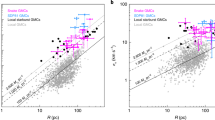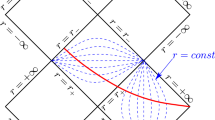Abstract
This paper considers the dynamics of a classical problem in astrophysics, the behavior of spherically symmetric gravitational collapse starting from a uniform, density cloud of interstellar gas. Previous work on this problem proposed a universal self-similar solution for the collapse yielding a collapsed mass much smaller than the mass contained in the initial cloud. This paper demonstrates the existence of a second threshold—not far above the marginal collapse threshold—above which the asymptotic collapse is not universal. In this regime, small changes in the initial data or weak stochastic forcing leads to qualitatively different collapse dynamics. In the absence of instabilities, a progressing wave solution yields a collapsed uniform core with infinite density. Under some conditions the instabilities ultimately lead to the well-known self-similar dynamics. However, other instabilities can cause the density profile to become non-monotone and produce a shock in the velocity. In presenting these results, we outline pitfalls of numerical schemes that can arise when computing collapse.
Similar content being viewed by others
REFERENCES
Russel E. Caflisch and George C. Papanicolaou, Singularities in Fluids, Plasmas, and Optics, Volume C404 of NATO ASI Series (Kluwer Academic Publishers, 1993).
Peter Constantin, Todd F. Dupont, Raymond E. Goldstein, Leo P. Kadanoff, Michael Shelley, and Su-Min Zhou, Droplet breakup in a model of the Hele-Shaw cell, Phys. Rev. E 47:4169–4181 (1993).
R. B. Larson, Numerical calculations of the dynamics of a collapsing protostar, Mon. Not. R. Astr. Soc. 145:271–295 (1969).
A. J. Majda, Vorticity and the mathematical theory of incompressible fluid flow, Comm. Pure Appl. Math. 39:5187–5220 (1986).
A. P. Boss, Giant planet formation by gravititational instability, Science 276:1836 (1997).
G. P. Kuiper, On the origin of the solar system, Proc. Natl. Acad. Sci. 37(1):1–14 (1951).
M. Mayor and D. Queloz, Nature 378:355 (1995).
H. Mizuno, Formation of giant planets, Prog. Theor. Phys. 64:544 (1980).
D. C. Black and M. S. Matthews, Protostars and Planets (The University of Arizona Press, Tucson, Arizona, 1985).
C. J. Lada and N. D. Kylafis, The Physics of Star Formation and Early Stellar Evolution (Kluwer Academic Publishers, Boston, 1991).
R. Capuzzo-Dolcetta, C. Chiosi, and A. Di Fazio, Physical Processes in Fragmentation and Star Formation (Kluwer Academic Publishers, Boston, 1990).
M. K.-H. Kiessling, On the equilibrium statistical mechanics of isothermal classical selfgravitating matter, J. Stat. Phys. 55:203–57 (1989).
M. V. Penston, Dynamics of self-gravitating gaseous spheres III, Mon. Not. R. Astr. Soc. 144:425–448 (1969).
Frank H. Shu, Self-similar collapse of isothermal spheres and star formation, Astrophys. J. 214:488–497 (1977).
F. H. Shu, F. C. Adams, and S. Lizano. Ann. Rev. Astron. Astrop. 25:23 (1987).
C. Hunter, The collapse of unstable isothermal spheres, Astrophys. J. 218:834–845 (1977).
P. N. Foster and R. A. Chevalier, Gravitational collapse of an isothermal sphere, Astrophys. J. 416:303–311 (1993).
J. H. Jeans, Astronomy and Cosmogony (Cambridge University Press, New York, 1929) (reprinted by Dover, 1961)
M. H. Heyer, F. J. Vrba, R. L. Snell, F. P. Schloerb, S. E. Strom, P. F. Goldsmith, and K. M. Strom, Astrophys. J. 324:311 (1987).
G. B. Whitham, Linear and Nonlinear Waves (Wiley-Interscience, New York, 1974).
L. I. Sedov, Similarity and Dimensional Methods in Mechanics, 10th ed. (CRC Press, Boca Raton, 1993).
Ya. B. Zeldovich and Yu P. Raizer, Elements of Gasdynamics and Classical Theory of Shock Waves (Academic Press, New York, 1968).
R. Courant and K. O. Friedirchs, Supersonic Flow and Shock Waves (Interscience Publisher, New York, 1948).
R. J. LeVeque, Numerical Methods for Conservation Laws (Birkhauser, Basel, 1992).
R. Emden, Gaskugeln—Anwendungen der Mechan, Warmtheorie (Druck und Verlag Von B. G. Teubner, Leipzig, 1907).
S. Chandrasekhar, An Introduction to the Study of Stellar Structure (Dover, New York, 1967).
H. T. Davis. Introduction to Nonlinear Differential and Integral Equations (Dover, New York, 1962).
P. Natarajan and D. Lynden-Bell, An analytic approximation to the isothermal sphere, Mon. Not. R. Astr. Soc. 286:268–270 (1997).
F. K. Liu, Polytropic gas spheres: An approximate analytic solution of the lane-emden equation, Mon. Not. R. Astr. Soc. 281:1197–1205 (1996).
M. P. Brenner, L. Levitov, and E. O. Budrene, Physical mechanisms for chemotactic pattern formation by bacteria, Biophys. J. (1998), to appear, April.
M. P. Brenner, P. Constantin, L. P. Kadanoff, A. Schenkel, and S. Venkataramani, Diffusion, attraction, collapse, preprint, 1998.
M. Kiessling, private communication.
D. Lynden-Bell and Wood, Mon. Not. R. Astr. Soc. 138:495–525 (1968).
G. Horwitz and J. Katz. Steepest descent technique and stellar equilibrium statistical mechanics, III. Stability of various ensembles. Astrophys. J. 222:941–958 (1978).
H. B. Keller, Numerical Solution of Two Point Boundary Value Problems (SIAM, Philadelphia, 1976).
R. D. Richtmyer and K. W. Morton, Difference Methods for Initial-Value Problems (John Wiley-Interscience, New York, 1967).
E. A. Dorfi and L. O'C. Drury, Simple adaptive grids for 1-d initial value problems, J. Comp. Phys. 69:175–195 (1987).
A. Whitworth and D. Summers, Self-similar condensation of spherically symmetric self-gravitating isothermal gas clouds, Mon. Not. R. Astr. Soc. 214:1–25 (1985).
A. Ori and T. Piran, A simple stability criterion for isothermal spherical self-similar flow, Mon. Not. R. Astr. Soc. 234:821–829 (1988).
R. B. Larson, Cloud fragmentation and stellar masses, Mon. Not. R. Astr. Soc. 214:379–398 (1985).
R. B. Larson, Towards understanding the stellar initial mass function, Mon. Not. R. Astr. Soc. 256:641–646 (1992).
O. I. Bogoyavlensky, Methods in the ualitative Theory of Dynamical Systems in Astrophysics and Gas Dynamics (Springer-Verlag, Berlin, 1985).
T. Hanawa and K. Nakayama, Stability of similarity solutions for a gravitationally contracting isothermal sphere: Convergence to the Larson-Penston solution, Astrophys. J. 484:238–244 (1997).
Author information
Authors and Affiliations
Rights and permissions
About this article
Cite this article
Brenner, M.P., Witelski, T.P. On Spherically Symmetric Gravitational Collapse. Journal of Statistical Physics 93, 863–899 (1998). https://doi.org/10.1023/B:JOSS.0000033167.19114.b8
Issue Date:
DOI: https://doi.org/10.1023/B:JOSS.0000033167.19114.b8




